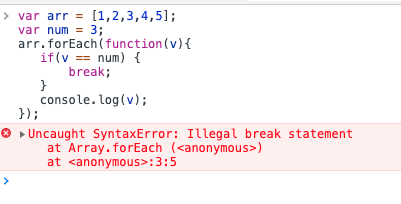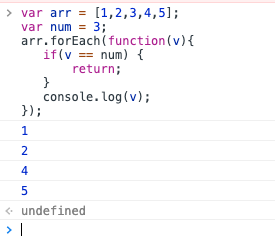浅谈 ForEach 和 For
1. ForEach
Javascript Array forEach() 中无法 return 和 break
var arr = [1,2,3,4,5];
var num = 3;
arr.forEach(function(v){
if(v == num) {
break;
}
console.log(v);
});
会报如下错误:

var arr = [1,2,3,4,5];
var num = 3;
arr.forEach(function(v){
if(v == num) {
return;
}
console.log(v);
});
使用return也不能跳出整个循环:

forEach 实现的源代码
Array.prototype.forEach = function(fun /*, thisp*/)
{
var len = this.length;
if (typeof fun != "function")
throw new TypeError();
var thisp = arguments[1];
for (var i = 0; i < len; i++)
{
if (i in this)
fun.call(thisp, this[i], i, this);
}
};
针对这个问题可以使用数组的另外两个方法some()与every():
some():当内部return true时跳出整个循环
var arr = [1,2,3,4,5];
var num = 3;
arr.some(function(v){
if(v == num) {
return true;
}
console.log(v);
});
// 1
// 2
// true
every():当内部return false时跳出整个循环
var arr = [1,2,3,4,5];
var num = 3;
arr.every(function(v){
if(v == num) {
return false;
}else{
console.log(v);
return true;
}
});
// 1
// 2
// false
2. for 和 forEach 性能对比
let arrs = new Array(100_000);
console.time('for');
for (let i = 0; i < arrs.length; i++) {};
console.timeEnd('for');
console.time('forEach');
arrs.forEach((arr) => {});
console.timeEnd('forEach');
// for: 2.275146484375ms
// forEach: 0.23486328125ms
在10万这个级别下, forEach 的性能是for的 10 倍
let arrs = new Array(1_000_000);
console.time('for');
for (let i = 0; i < arrs.length; i++) {};
console.timeEnd('for');
console.time('forEach');
arrs.forEach((arr) => {});
console.timeEnd('forEach');
// for: 9.620849609375ms
// forEach: 2.5791015625ms
在100万这个级别下, forEach 的性能是for的 4 倍
let arrs = new Array(100_000_000);
console.time('for');
for (let i = 0; i < arrs.length; i++) {};
console.timeEnd('for');
console.time('forEach');
arrs.forEach((arr) => {});
console.timeEnd('forEach');
// for: 769.68017578125ms
// forEach: 1661.35009765625ms
在1亿这个级别下, for 的性能是forEach的 2 倍多
数据量越大,forEach的性能低于for的性能
3. for 嵌套循环
console.time('first time');
for (let i = 0; i < 100; i++) {
for (let j = 0; j < 1000; j++) {
for (let k = 0; k < 10000; k++) {
}
}
}
console.timeEnd('first time');
console.time('two time');
for (let i = 0; i < 10000; i++) {
for (let j = 0; j < 1000; j++) {
for (let k = 0; k < 100; k++) {
}
}
}
console.timeEnd('two time');
// first time: 289.223876953125ms
// two time: 432.072021484375ms
为什么呢?
1、i会循环100次,判断i<100 100次 j会循环100 * 1000次,判断j<100 100 * 1000次 k会循环100 * 1000 * 10000次,判断k<100 100 * 1000 * 10000次
2、i会循环10000次,判断i<100 10000次 j会循环10000 * 1000次,判断j<100 10000 * 1000次 k会循环100 * 1000 * 10000次, 判断k<100 100 * 1000 * 10000次
虽然判断k<100的次数都是一样的 但是前面两种判断(i 和 j)就不一样了,由此可以看见时间长短。